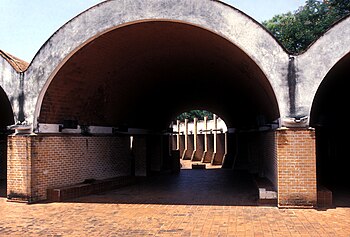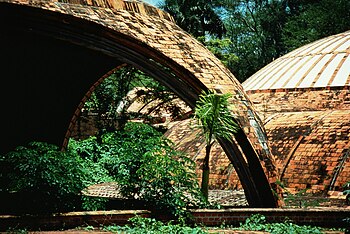 |
| School of Music near the Jaguey Tree, uphill from the stream (Photo credit: Wikipedia) |
 |
| School of Plastic Arts, Ricardo Porro (Photo credit: Wikipedia) |
 |
| School of Dramatic Arts, Roberto Gottardi (Photo credit: Wikipedia) |
 |
| School of Ballet, Vittorio Garatti (Photo credit: Wikipedia) |
 |
| English: View downhill towards stream and the School of Ballet (Photo credit: Wikipedia) |
 |
| View towards entrance from the School of Modern Dance (Photo credit: Wikipedia) |
Having made documentary films in my day, I know how
difficult it is to express ideas and issues in any form that will not bore the
audience to tears. Which is why I have such astonished admiration for a film
recently broadcast on Al Jazeera called Cuba’s
Unfinished Spaces made by Alysa Nahmias and Benjamin Murray.
Although the ostensible subject
of this film is the saga of the construction of five Art Schools in Cuba in the
early years of the revolution, the filmmakers have managed to make revolution,
in the full meaning of that word, its real subject --- the delights,
excitements, inspirations of revolution on the one hand, and the despairs and
crushing disappointment that sets in as the revolution hardens, becomes
bureaucratic, and the romance and excitement gradually degenerates, as one of the architects in this
film said, “into a rule.”
This film, in other words, is
absolutely worthy of the revolution which inspired it, of the marvellous old
men who, as youngsters, seized their chance and managed to create the Schools
of Modern Dance, Ballet, Music, Dramatic
Arts, and Plastic Arts that have been recognized by authorities outside Cuba as
precious examples of modern architecture, while within Cuba they have been
neglected as trees and plants have overgrown them.
The story begins when Fidel and
Che one day go to the immense layout of the local golf course, in the Country
Club, a preserve of the rich before the revolution, and Fidel says how
wonderful it would be to use this space for the use of students of the arts.
The next act comes when Fidel, driving in Havana one evening, spots Selma Dias,
a young woman described as “a real revolutionary and an architect”, stops the
car, orders to get in, and drives her to the golf course ---she can see nothing because it is already
dark --- where he announces she is to be in charge of the creation on this land
of Art Schools at which thousands of young Cubans will be educated. She accepts
the charge, goes to an architect of her acquaintance Ricardo Porro, tells him
of this revelation, and asks him to be the architect in charge. He is amazed,
staggered, of course, he says, he will accept. But says Selma, there is a
condition. The work has to be up and under construction in two months. Two
months! says Ricardo. Impossible! That's the offer, says Selma, take it or
leave it. I take it, says Ricardo.
Soon thereafter, Fidel gathered
the architects of Cuba together and told them the era of big buildings, of
luxury projects, is over. “We are building now for the people,” he said. Porro said some architects left Cuba
immediately, but he recruited two
Italians who had previously worked with him in Venezuela, Roberto Gottardi and
Vittorio Garatti . He was interested in the work that an elderly man called Gumensindo
had been doing experimenting with ways to enclose space without using expensive
materials, and he decided that this work, the placing together of bricks in
such a way as to form vaults --- very similar to the way an Inuit igloo is
constructed --- would be the basic method used in building the schools. Some
people did not believe in the vaults, because the architects were men with very
little experience, “but everything we did was daring,” one of them said. “We
unleashed our dreams and visions.” The designs had no doors, temples or
columns. “I thought of my school as an initiation ritual,” said one of them.
“That is why it is full of indirect passages, mysterious and tortuous.” Porro
said: “I tried to make the school of plastic arts as an image of this
romantical moment of the revolution. I wanted to express in the School the
atmosphere I felt in Cuba during the revolution. I thought of the Schools as if
there were one million people in a piazza, and then they would each go in their
own different direction.”
The construction started almost
as soon as the first drawings were made, and before the Schools were finished,
students were already at work. Everyone from Porro at the top down to the
youngest student, was moved by the absolute
freedom they were given, and this was, perhaps, the source of their
downfall. Porro kept urging his architects and workers --- at the maximum they
would have 800 workers busy with the construction ---- not to waste time on
minor things, because “perhaps one day it is all going to be stopped.”
He was a wise man. During the
sixties the Soviet Union became Cuba’s main supporter, and the events of the
Cold War became important and changed national priorities. Soviet ideas begin to influence the leaders,
and nothing in Soviet attitudes as translated to Cuba had to do with beauty,
and those who were concerned to make these beautiful Art Schools began to come
under criticism as being bourgeois,
intellectual, elitist. Pretty soon the workers made available were down to
twenty-five, and, as Porro remarked he found himself in a situation like that
described by Kafka. “One day you learn that you have been accused of something,
then you have been judged, then you realize you are guilty, and nobody tells
you of what.” Porro, who had been a friend of Castro’s when they were both
students, and had in fact been arrested before the revolution, and had to leave
the country, again had to leave for France, where he worked across Europe with
distinction as an architect until his death in 2014 at the age of 89. The
film-makers, who spent ten years putting this film together, were lucky to have
interviewed him extensively before his death.
Eventually Che wrote an article
in which he criticized the freedoms exercised in the Art Schools, which found
themselves thereafter subject to military discipline, and were forced to expel gay
students. In the end only Porro’s Plastic Arts and Modern Dance School ever got
finished, and Garatti who had designed the Music and Ballet schools was forced
out of the country in 1974.
Gradually, however, word spread
around the world of the tragic neglect suffered by what so many regarded as the
greatest architectural achievement of the Cuban revolution, and the film has a
brief statement in which Castro declares that when someone showed him a drawing
of one of the Schools, “it was like
falling in love with a young girl.” He declared that the work must be
rehabilitated and completed, and said, “I was ignorant.” (Quite an admission for
a man whose word was law.) So began the slow process of reconstruction and
rehabilitation, which, according to the film has slowed since the resignation
of Fidel.
The rehabilitation of this work
at an international level was signalled by the publication in 2011 of a book by
a Californian John Loomis called Revolution
of Form: Cuba’s Forgotten Art Schools. Subsequently many exhibitions have
toured showing photos of he work, and it has even been the subject of an opera.
The World Monuments Fund placed the Art Schools on their watch List, and all
this attention persuaded Cuba to recommend the project as a World Heritage site
that has outstanding universal value to the world.
I believe this film about this extraordinary
achievement is itself wonderful in that
it gives such a clear-headed, in some ways inspiring, and in other ways
depressing, view of the meaning of revolution. Something a guy like me, who
tends to sympathize with revolutions, is in dire need of.
No comments:
Post a Comment